towing Acura ILX Hybrid 2013 Owner's Manual
[x] Cancel search | Manufacturer: ACURA, Model Year: 2013, Model line: ILX Hybrid, Model: Acura ILX Hybrid 2013Pages: 365, PDF Size: 8.63 MB
Page 1 of 365

ContentsThis owner’s manual should be considered a permanent part of the
vehicle and should remain with the vehicle when it is sold.
This owner’s manual covers all models of your vehicle. You may find
descriptions of equipment and features that are not on your
particular model.
Images throughout this owner’s manual (including the front cover)
represent features and equipment that are available on some, but
not all, models. Your particular model may not have some of these
features.
This owner's manual is for vehicles sold in the United States and
Canada.
The information and specifications included in this publication were
in effect at the time of approval for printing. Honda Motor Co., Ltd.
reserves the right, however, to discontinue or change specifications
or design at any time without notice and without incurring any
obligation.
2Safe Driving P. 27For Safe Driving P. 28 Seat Belts P. 32 Airbags P. 392Instrument Panel P. 69Indicators P. 70 Gauges and Multi-Information Display P. 862Controls P. 103Setting the Clock P. 104 Locking and Unlocking the Doors P. 105
Opening and Closing the Moonroof P. 123
Adjusting the Seats P. 135 Interior Lights/Interior Convenience Items P. 1412Features P. 151Audio System P. 152 Audio System Basic Operation P. 155
HomeLink® Universal Transceiver
* P. 187
2Driving P. 219Before Driving P. 220 Towing a Trailer P. 225
Multi-View Rear Camera
* P. 253 Refueling P. 254
2Maintenance P. 259Before Performing Maintenance P. 260 Maintenance Minder
TM P. 263
Checking and Maintaining Wiper Blades P. 292
Climate Control System Maintenance P. 305
2Handling the Unexpected P. 311Tools P. 312 If a Tire Goes Flat P. 313
Overheating P. 334 Indicator, Coming On/Blinking P. 3362Information P. 345Specifications P. 346 Identification Numbers P. 348
Emissions Testing P. 351 Warranty Coverages P. 353
Page 2 of 365
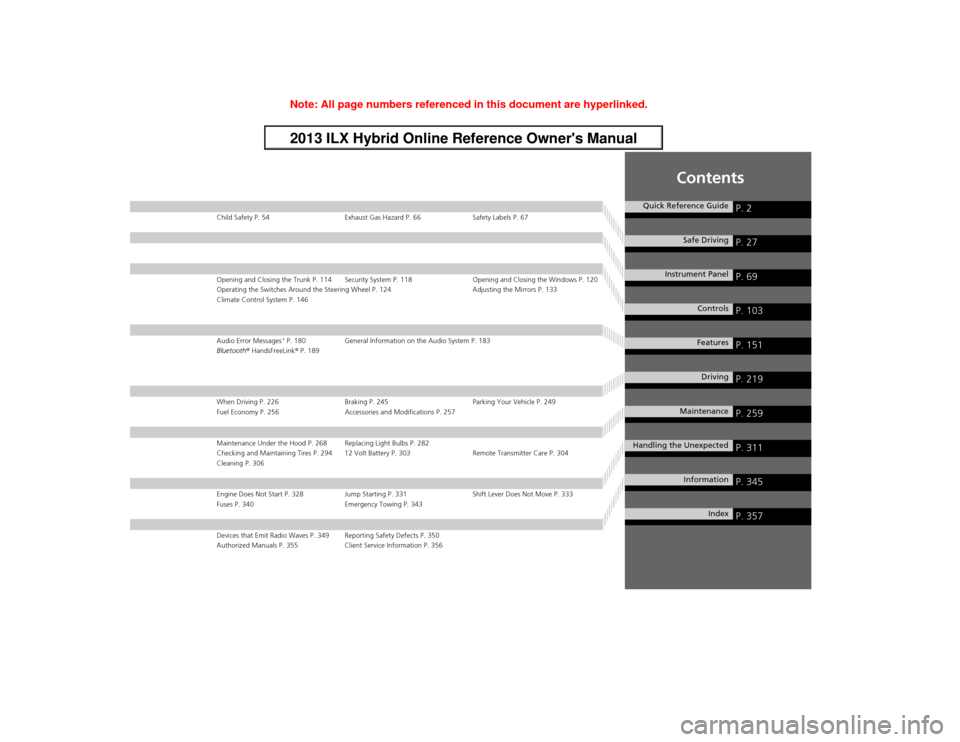
Contents
Child Safety P. 54 Exhaust Gas Hazard P. 66 Safety Labels P. 67Opening and Closing the Trunk P. 114 Security System P. 118 Opening and Closing the Windows P. 120
Operating the Switches Around the Steering Wheel P. 124 Adjusting the Mirrors P. 133
Climate Control System P. 146Audio Error Messages
* P. 180 General Information on the Audio System P. 183
Bluetooth® HandsFreeLink® P. 189
When Driving P. 226 Braking P. 245 Parking Your Vehicle P. 249
Fuel Economy P. 256 Accessories and Modifications P. 257Maintenance Under the Hood P. 268 Replacing Light Bulbs P. 282
Checking and Maintaining Tires P. 294 12 Volt Battery P. 303 Remote Transmitter Care P. 304
Cleaning P. 306Engine Does Not Start P. 328 Jump Starting P. 331 Shift Lever Does Not Move P. 333
Fuses P. 340 Emergency Towing P. 343Devices that Emit Radio Waves P. 349 Reporting Safety Defects P. 350
Authorized Manuals P. 355 Client Service Information P. 356
Quick Reference Guide
P. 2
Safe Driving
P. 27
Instrument Panel
P. 69
Controls
P. 103
Features
P. 151
Driving
P. 219
Maintenance
P. 259
Handling the Unexpected
P. 311
Information
P. 345
Index
P. 357
Page 22 of 365
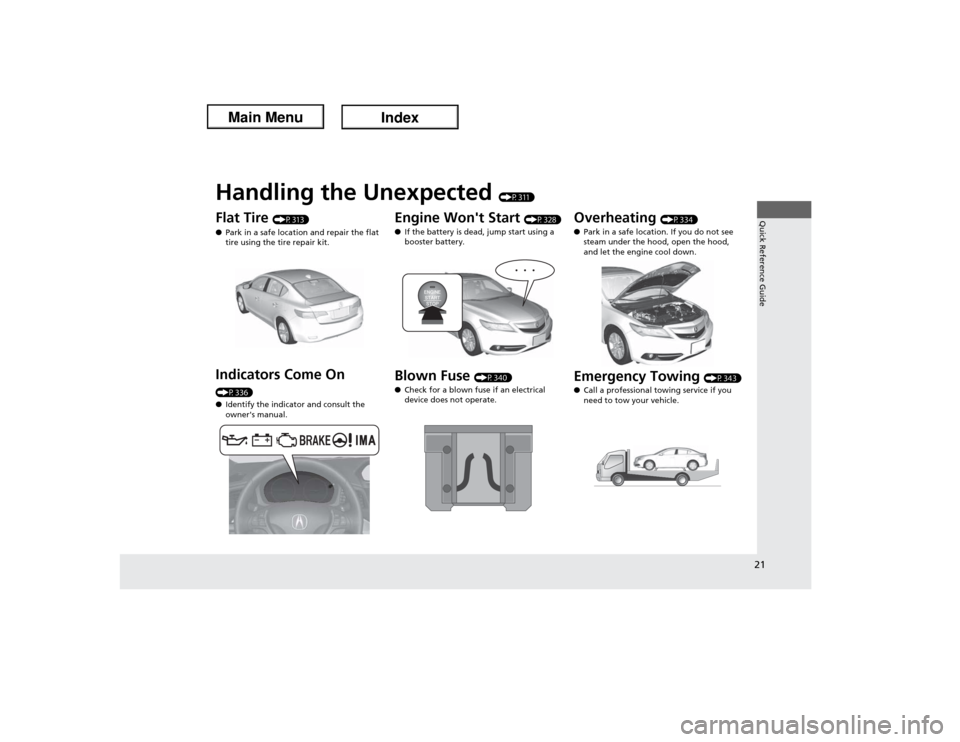
Quick Reference Guide21
Handling the Unexpected
(P311)
Flat Tire
(P313)
●Park in a safe location and repair the flat
tire using the tire repair kit.
Indicators Come On (P336)
●Identify the indicator and consult the
owner's manual.
Engine Won't Start
(P328)
●If the battery is dead, jump start using a
booster battery.
Blown Fuse
(P340)
●Check for a blown fuse if an electrical
device does not operate.
Overheating
(P334)
●Park in a safe location. If you do not see
steam under the hood, open the hood,
and let the engine cool down.
Emergency Towing
(P343)
●Call a professional towing service if you
need to tow your vehicle.
Page 220 of 365
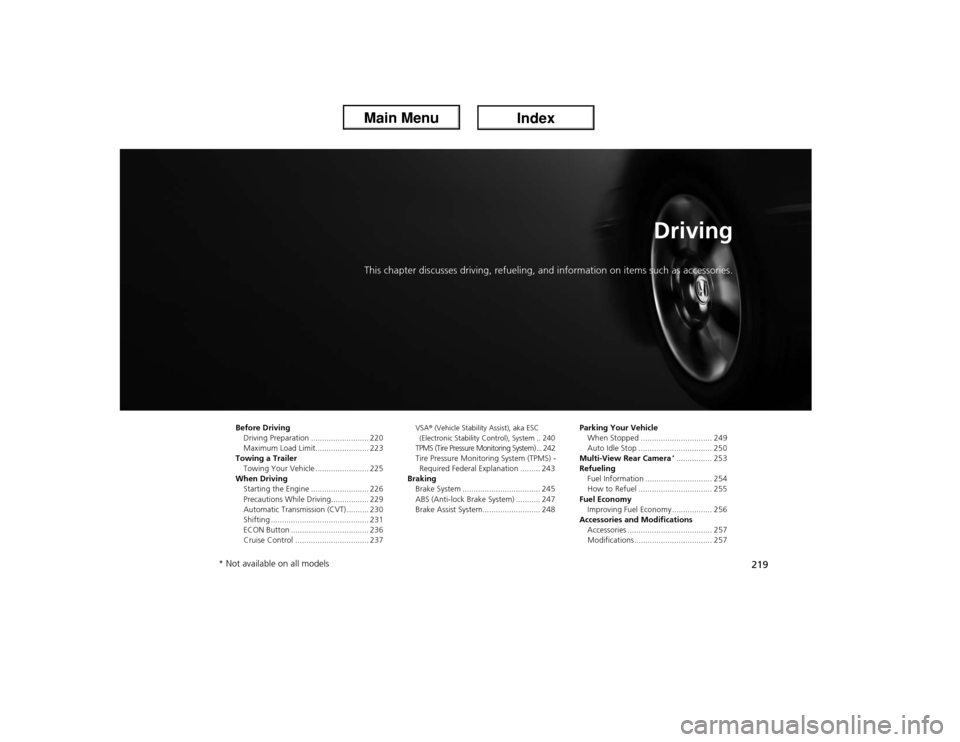
219
Driving
This chapter discusses driving, refueling, and information on items such as accessories.
Before Driving
Driving Preparation .......................... 220
Maximum Load Limit........................ 223
Towing a Trailer
Towing Your Vehicle ........................ 225
When Driving
Starting the Engine .......................... 226
Precautions While Driving................. 229
Automatic Transmission (CVT) .......... 230
Shifting ............................................ 231
ECON Button ................................... 236
Cruise Control ................................. 237
VSA® (Vehicle Stability Assist), aka ESC
(Electronic Stability Control), System .. 240TPMS (Tire Pressure Monitoring System) ... 242
Tire Pressure Monitoring System (TPMS) -
Required Federal Explanation ......... 243
Braking
Brake System ................................... 245
ABS (Anti-lock Brake System) ........... 247
Brake Assist System.......................... 248Parking Your Vehicle
When Stopped ................................ 249
Auto Idle Stop ................................. 250
Multi-View Rear Camera
*................ 253
Refueling
Fuel Information .............................. 254
How to Refuel ................................. 255
Fuel Economy
Improving Fuel Economy .................. 256
Accessories and Modifications
Accessories ...................................... 257
Modifications................................... 257
* Not available on all models
Page 224 of 365

223
uuBefore DrivinguMaximum Load Limit
Continued
Driving
Maximum Load LimitThe maximum load for your vehicle is 850 lbs (385 kg).
See Tire and Loading Information label attached to the driver's doorjamb.
This figure includes the total weight of all occupants, cargo, and
accessories, and the tongue load if you are towing a trailer.
Steps for Determining Correct Load Limit -
(1)Locate the statement “The combined weight of occupants and
cargo should never exceed XXX kg or XXX lbs.” on your
vehicle's placard.
(2)Determine the combined weight of the driver and passengers
that will be riding in your vehicle.
(3)Subtract the combined weight of the driver and passengers
from XXX kg or XXX lbs.
(4)The resulting figure equals the available amount of cargo and
luggage load capacity. For example, if the “XXX” amount
equals 1,400 lbs. and there will be five 150 lb. passengers in
your vehicle, the amount of available cargo and luggage load
capacity is 650 lbs.
(1,400 - 750 (5 x 150) = 650 lbs.)
1Maximum Load Limit
Gross Vehicle Weight Rating (GVWR):
The maximum allowable weight of the vehicle, all
occupants, all accessories, and all cargo.
2Specifications P. 346
Gross Axle Weight Rating (GAWR):
The maximum allowable weight of the vehicle axle.
2Specifications P. 346
3
WARNING
Overloading or improper loading
can affect handling and stability
and cause a crash in which you
can be hurt or killed.
Follow all load limits and other
loading guidelines in this manual.
Label Example
Page 225 of 365
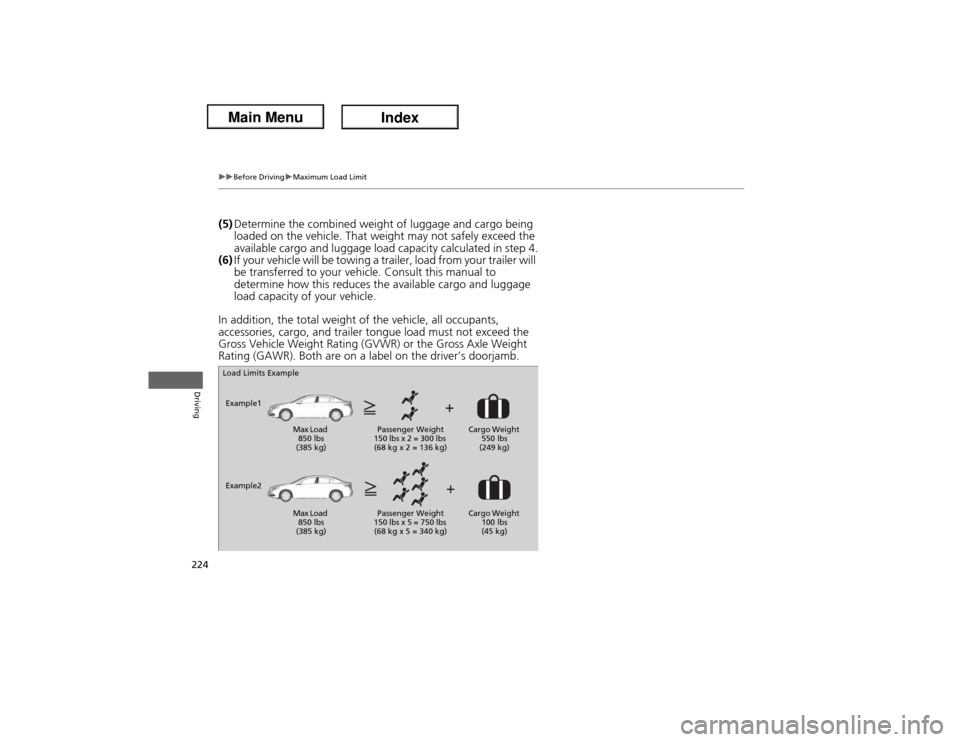
224
uuBefore DrivinguMaximum Load Limit
Driving
(5)Determine the combined weight of luggage and cargo being
loaded on the vehicle. That weight may not safely exceed the
available cargo and luggage load capacity calculated in step 4.
(6)If your vehicle will be towing a trailer, load from your trailer will
be transferred to your vehicle. Consult this manual to
determine how this reduces the available cargo and luggage
load capacity of your vehicle.
In addition, the total weight of the vehicle, all occupants,
accessories, cargo, and trailer tongue load must not exceed the
Gross Vehicle Weight Rating (GVWR) or the Gross Axle Weight
Rating (GAWR). Both are on a label on the driver’s doorjamb.Load Limits Example
Example1
Max Load
850 lbs
(385 kg)Passenger Weight
150 lbs x 2 = 300 lbs
(68 kg x 2 = 136 kg)Cargo Weight
550 lbs
(249 kg)
Example2
Max Load
850 lbs
(385 kg)Passenger Weight
150 lbs x 5 = 750 lbs
(68 kg x 5 = 340 kg)Cargo Weight
100 lbs
(45 kg)
Page 226 of 365
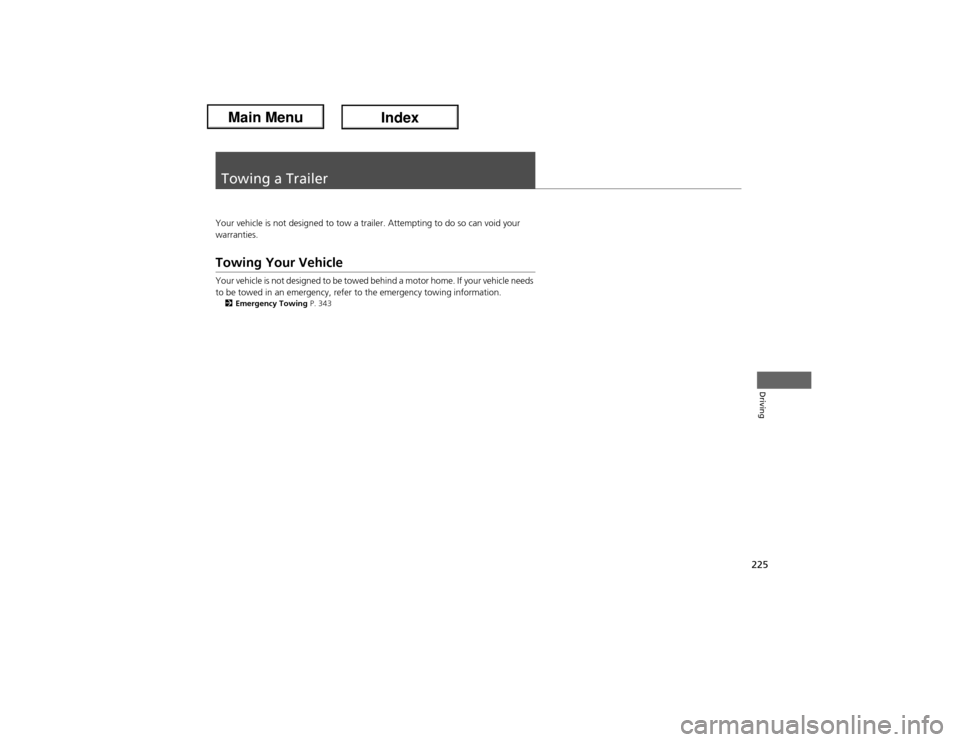
225Driving
Towing a TrailerYour vehicle is not designed to tow a trailer. Attempting to do so can void your
warranties.Towing Your VehicleYour vehicle is not designed to be towed behind a motor home. If your vehicle needs
to be towed in an emergency, refer to the emergency towing information.2Emergency Towing P. 343
Page 312 of 365
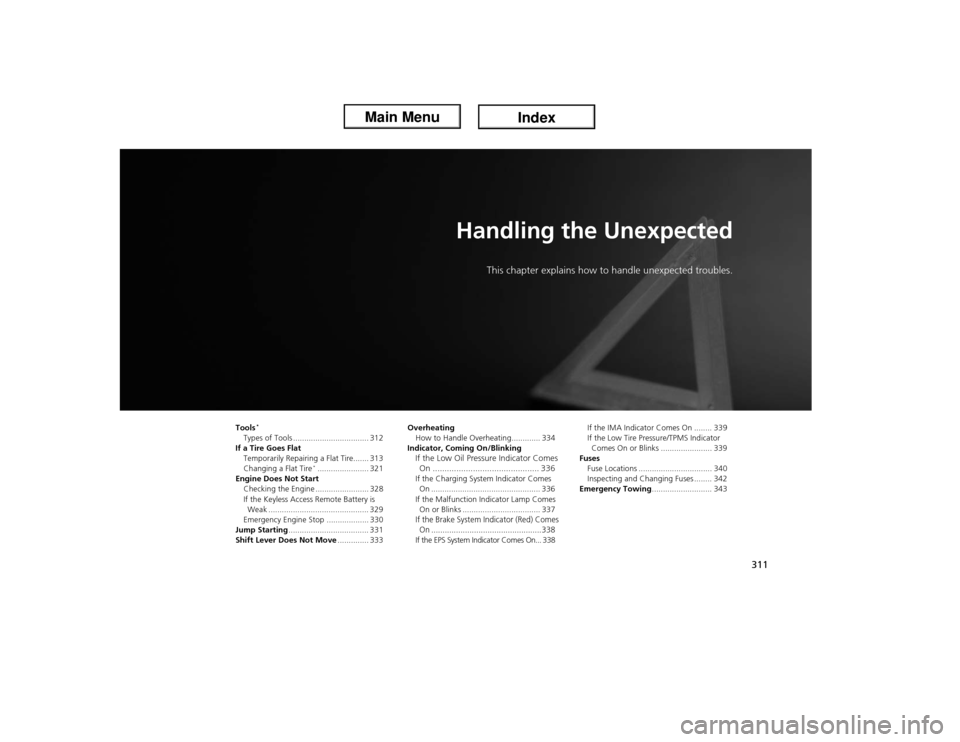
311
Handling the Unexpected
This chapter explains how to handle unexpected troubles.
Tools
*
Types of Tools .................................. 312
If a Tire Goes Flat
Temporarily Repairing a Flat Tire....... 313
Changing a Flat Tire
*....................... 321
Engine Does Not Start
Checking the Engine ........................ 328
If the Keyless Access Remote Battery is
Weak ............................................. 329
Emergency Engine Stop ................... 330
Jump Starting.................................... 331
Shift Lever Does Not Move.............. 333Overheating
How to Handle Overheating............. 334
Indicator, Coming On/Blinking
If the Low Oil Pressure Indicator Comes
On ............................................. 336If the Charging System Indicator Comes
On ................................................. 336
If the Malfunction Indicator Lamp Comes
On or Blinks ................................... 337If the Brake System Indicator (Red) Comes
On .................................................338If the EPS System Indicator Comes On... 338If the IMA Indicator Comes On ........ 339
If the Low Tire Pressure/TPMS Indicator
Comes On or Blinks ....................... 339
Fuses
Fuse Locations ................................. 340
Inspecting and Changing Fuses ........ 342
Emergency Towing........................... 343
Page 319 of 365
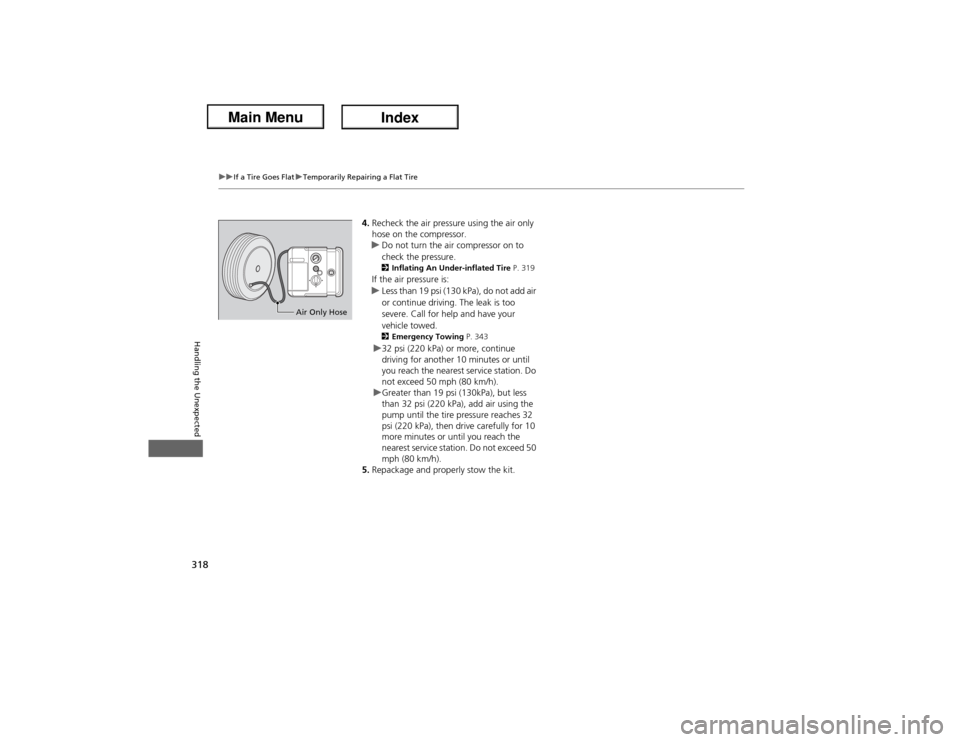
318
uuIf a Tire Goes FlatuTemporarily Repairing a Flat Tire
Handling the Unexpected
4.Recheck the air pressure using the air only
hose on the compressor.
uDo not turn the air compressor on to
check the pressure.
2Inflating An Under-inflated Tire P. 319If the air pressure is:
uLess than 19 psi (130 kPa), do not add air
or continue driving. The leak is too
severe. Call for help and have your
vehicle towed.2Emergency Towing P. 343u32 psi (220 kPa) or more, continue
driving for another 10 minutes or until
you reach the nearest service station. Do
not exceed 50 mph (80 km/h).
uGreater than 19 psi (130kPa), but less
than 32 psi (220 kPa), add air using the
pump until the tire pressure reaches 32
psi (220 kPa), then drive carefully for 10
more minutes or until you reach the
nearest service station. Do not exceed 50
mph (80 km/h).
5.Repackage and properly stow the kit.
Air Only Hose
Page 329 of 365
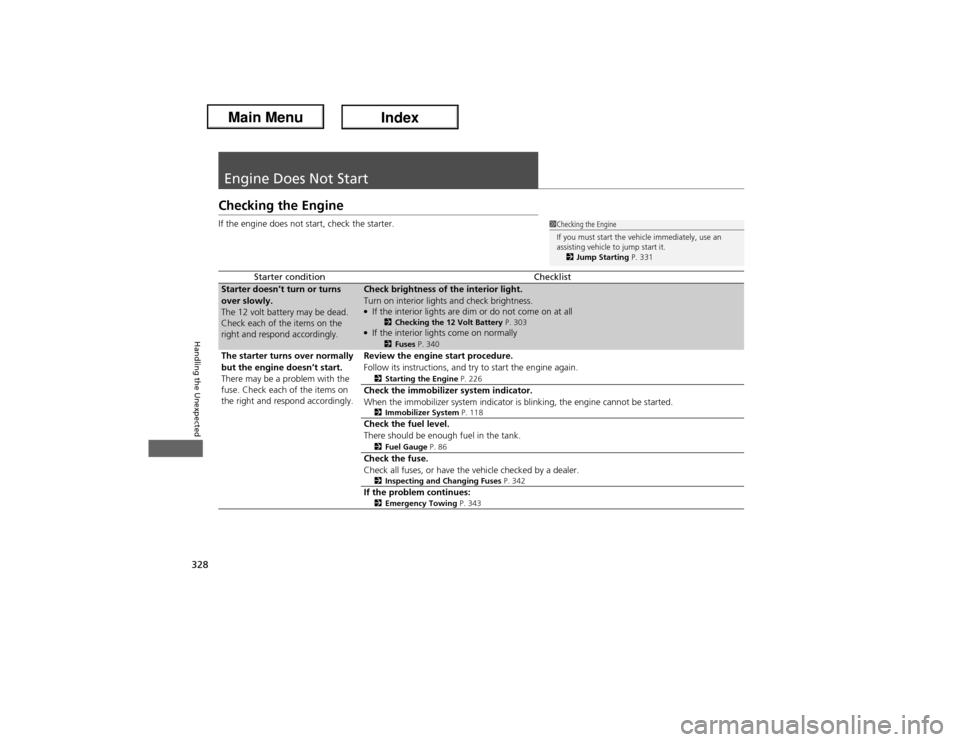
328Handling the Unexpected
Engine Does Not StartChecking the EngineIf the engine does not start, check the starter.
Starter condition
Checklist
Starter doesn’t turn or turns
over slowly.
The 12 volt battery may be dead.
Check each of the items on the
right and respond accordingly.
Check brightness of the interior light.
Turn on interior lights and check brightness.●If the interior lights are dim or do not come on at all
2Checking the 12 Volt Battery P. 303
●If the interior lights come on normally
2Fuses P. 340
The starter turns over normally
but the engine doesn’t start.
There may be a problem with the
fuse. Check each of the items on
the right and respond accordingly.
Review the engine start procedure.
Follow its instructions, and try to start the engine again.
2Starting the Engine P. 226Check the immobilizer system indicator.
When the immobilizer system indicator is blinking, the engine cannot be started.2Immobilizer System P. 118Check the fuel level.
There should be enough fuel in the tank.
2Fuel Gauge P. 86Check the fuse.
Check all fuses, or have the vehicle checked by a dealer.2Inspecting and Changing Fuses P. 342If the problem continues:2Emergency Towing P. 343
1Checking the Engine
If you must start the vehicle immediately, use an
assisting vehicle to jump start it.
2Jump Starting P. 331